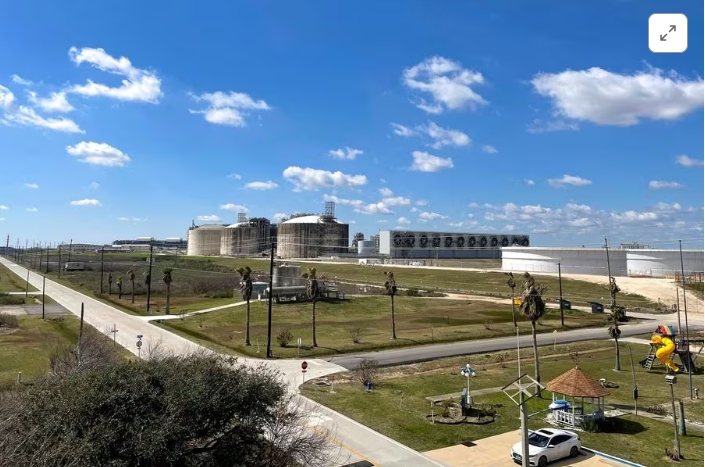
Front-month futures for gas delivered at Henry Hub in Louisiana slumped to $1.58 per million British thermal units on Feb. 15, the lowest in real terms since the futures contract was launched in 1990.
Working gas stocks stood at 2,535 billion cubic feet (bcf) on Feb. 9, the highest for the time of year since 2016 and before that 2012, according to data from the U.S. Energy Information Administration (EIA).
Inventories were 346 bcf (+16% or +1.04 standard deviations) above the prior ten-year average, swelling from 64 bcf (+2% or +0.24 standard deviations) above at the start of the heating season on Oct. 1.
Chartbook: U.S. gas inventories and prices, opens new tabApart from a brief period of intense cold in the middle of January, the winter of 2023/24 has mostly been warmer than average, depressing direct gas consumption as well as gas-fired power generation.
The Lower 48 states experienced a total of 2,603 population-weighted heating degree days between July 1, 2023, and Feb. 14, 2024, which was 11% below the long-term seasonal average of 2,935.
Lower 48 population-weighted heating degree days were below the long-term average on 98 of 137 days between Oct. 1 and Feb. 14.
December was especially mild, causing inventories to deplete by only 300 bcf, the smallest seasonal draw since December 2015, and compared with a ten-year average draw of 478 bcf.
EL NINO IMPACT
Strong El Niño conditions in the central-eastern Pacific this winter directed warmer air into the northern United States and ensured temperatures have been much milder than usual.
Sea surface temperatures in the central-eastern Pacific were almost 2 degrees Celsius warmer than average in December, the warmest since 2015 and before that 1997, both exceptionally strong El Niño episodes.
A strong El Niño is generally associated with warmer-than-average winter temperatures across the United States, especially in the northern tier of states stretching from Washington through Illinois to Maine.
Since 1950, there have been six strong El Niño episodes during the northern hemisphere winter (1957/58, 1965/66, 1982/83, 1991/92, 1997/98 and 2015/16) and one borderline case (2009/10).
Since 1973, during winters with a strong episode, the number of U.S. heating degree days was 7% lower on average compared with years without (or 10% lower if the borderline case is excluded).
The reduction in heating demand of 11% so far during winter 2023/24 is therefore consistent with previous strong El Niño episodes.
TOO MUCH GAS
Ultra-low futures prices are sending the strongest possible signal about the need for a slowdown in drilling and production to help rebalance the market.
The number of rigs drilling for gas averaged just 119 in January 2024, down from 162 in September 2022 - a delayed response to the fall in prices after they spiked following Russia’s invasion of Ukraine in February 2022.
But the rig count has been broadly constant for the last five months and well productivity has continued to increase as companies focus on the most prospective locations and drill longer horizontal well sections.
In addition, more gas is being produced and captured from wells drilled primarily to extract oil, adding to production growth.
Dry gas production amounted to 3,178 bcf in November 2023 (the latest month for which data is available) which was 111 bcf (+4%) higher than in the same month a year earlier.
Production in the first eleven months of 2023 was up by 1,339 bcf (+4%) compared with the same period in 2022.
Total exports of pipeline and liquefied gas also increased but only by 594 bcf, according to data compiled by the EIA.
The slump in real prices to multi-decade lows is signalling the urgent need for a further slowdown in well drilling and completions.
In recent days, several gas producers have announced plans to cut capital expenditure and reduce the number of active rigs and completion crews.
In the months ahead, exceptionally cheap gas should also maximise more gas-fired generation at the expense of coal, eroding some more of the excess stocks.
PURGING STOCKS
Prices for gas delivered in March (the last winter month) have already slipped 7 cents below April (the first spring-summer month) having begun the winter at a premium of 21 cents.
Prices will have to fall low enough for long enough to purge excess inventory inherited from winter 2023/24 from storage and make room for more to be added this summer ahead of winter 2024/25.
Prices have fallen so low and sentiment is so bearish that from a purely positioning perspective the balance of risks must be to the upside.
But portfolio investors have tried (and failed) three times already in the last twelve months to identify the turning point, causing a temporarily rise then retreat in prices.
Hedge funds and other managers purchased futures and options between February and July 2023 (+1,943 bcf), then again in September-October 2023 (+1,216 bcf) and between December 2023 and January 2024 (+1,409 bcf).
Each time they have been beaten back by the continued rise in stocks and a further slide in prices.